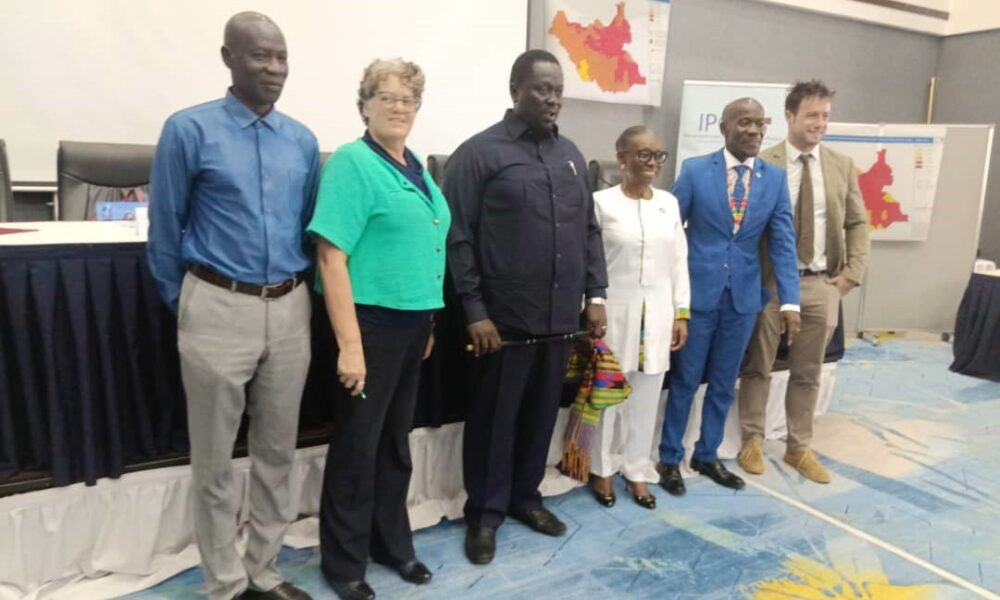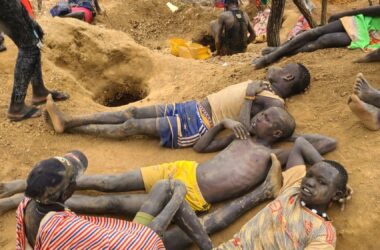By Kei Emmanuel Duku
Funding cuts, conflicts, and widespread food insecurity are significant factors to alarming surge in malnutrition across South Sudan.
World Food Program (WFP) Country Director, Mary Ellen McGroarty said these challenges severely affect the fight against malnutrition in the country.
McGroarty made her remarks during the launch of the Integrated Food Security Phase Classification (IPC) report in Juba on Thursday.
She noted that children, nursing women, and pregnant mothers are the most affected categories seeking health services nationwide.
The latest report, she said, highlights a devastating deterioration in the malnutrition situation, with 200,000 young children at high risk of malnutrition and another 1.2 million women classified as malnourished under IPC Phase 5.
She specifically pointed to four counties—Ulang, Nasir, Baliet, and Rubkona—which are already classified under IPC Phase 5, indicating catastrophic levels of food insecurity.
In these areas, the compounding factors of disease outbreaks, including cholera, coupled with funding shortfalls, have created a dire situation for residents.
The challenges are further exacerbated by the on-going conflict in Sudan, which has driven approximately 39,000 South Sudanese returnees and refugees into areas already grappling with limited resources.
McGroarty noted that these displaced populations face immense difficulties in rebuilding their livelihoods and securing food, adding pressure to an already strained humanitarian response.
“There is a link between conflict and hunger and how conflict really does have a devastating impact on people’s food security,” Ellen stated. “These IPC results do indicate the severe humanitarian needs that the country is still facing, and as humanitarian agencies, we are deeply concerned.”
According to the latest IPC reports, over 7.7 million people—57% of the population—are classified under IPC Phase 3 and above.
This means they are unable to consistently and predictably provide a meal a day for their families. McGroarty attributed this to conflict, economic shocks, and climate-related events.
McGroarty underscored that while conflict, market disruptions, and natural disasters remain significant drivers of food insecurity, the recent USAID funding cuts by the United Sates America government have created a critical gap in the humanitarian safety net.
She reiterated the urgent need for an increased multi-sectoral response to prevent further escalation of the malnutrition crisis and to protect the lives of those most at risk in the country.
“We do want to encourage the government to continue with some of the very fruitful efforts that are going on,” the WFP Country Director added. “Strategic and important investments in agriculture should be made key to make that hunger-free South Sudan a reality.”
Meanwhile, Meshack Malo, the Food and Agriculture Organization (FAO) Representative, stated that this critical deterioration is largely concentrated in conflict-affected regions. Counties such as Upper Nile, Pibor (with approximately 12,000 affected), Nasir (15,000), Malakal (10,000), and Ulang (7,000) are now home to these populations facing the most extreme levels of food deprivation.
However, amidst the worsening scenario, a beacon of hope emerges from 10 counties that have demonstrated significant improvement, moving from IPC Phase 4 (Emergency) to Phase 3 (Crisis).
These counties include Kapoeta North in Eastern Equatoria State; Cueibet County, Rumbek Centre and East, Yirol East and West Counties in Lake States; Aweil in Northern Bahr-El Ghazal; and Gogrial East and West in Warrap State.
Malo linked this improvement to the critical role of stability and peace in promoting agriculture, where farmers in stable areas have food surpluses they are eager to sell, highlighting the potential for recovery when security prevails.
“The underlying factor is instability,” Malo remarked. “The underlying factor in the 10 counties moving down from IPC-4 to 3, which is a big number, is stability.”
Currently, 2.4 million people are in IPC Phase 4 (Emergency), with a higher concentration of 5.2 million people in Phase 3 (Crisis).
Malo believes that if political leaders collaborate to foster lasting peace, the country could rapidly reduce the number of food-insecure individuals to levels seen previously, around one million.
“Fundamentally, when you see the changes within and among, peace comes out as one of the most fundamental factors that is flipping or that is pushing the indicator,” he concluded, emphasizing that peace is the cornerstone for reversing South Sudan’s deepening food insecurity.
Hussein Abdelbagi Akol Agany, South Sudan’s Minister of Agriculture and Food Security, appealed for support to help rebuild the country’s local market for easy access to agricultural produce.
To combat the surging cases of malnutrition, the Minister called for collective responsibility to support the country’s fragile health centers so that pregnant and breastfeeding women and children below the age of five can have access to medical treatment.
“We must make our roads accessible so our farmers can reach markets and food can reach families,” Abdelbagi concluded.
“We must stabilize our economy to protect our citizens from further suffering. Yes, the road ahead is difficult. Our people have shown extraordinary strength through conflict, hardship, and rebuilding. That same spirit must now lead us to conquer hunger and malnutrition.”




